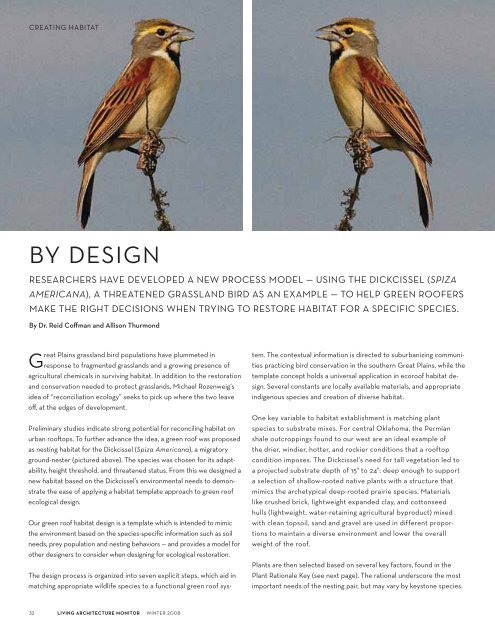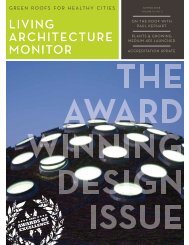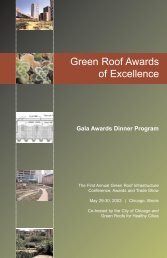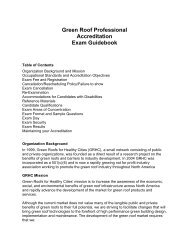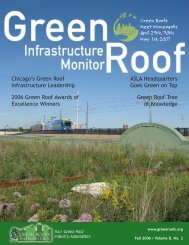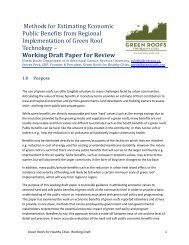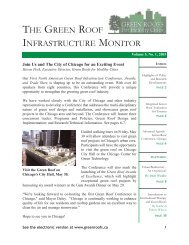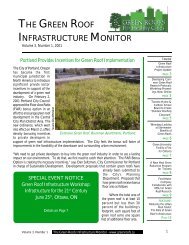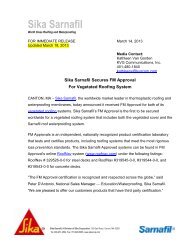Living Architecture Monitor - Green Roofs for Healthy Cities
Living Architecture Monitor - Green Roofs for Healthy Cities
Living Architecture Monitor - Green Roofs for Healthy Cities
You also want an ePaper? Increase the reach of your titles
YUMPU automatically turns print PDFs into web optimized ePapers that Google loves.
CREATINGHABITAT<br />
BYDESIGN<br />
RESEARCHERSHAVEDEVELOPEDANEWPROCESSMODEL—USINGTHEDICKCISSELSPIZA<br />
AMERICANAATHREATENEDGRASSLANDBIRDASANEXAMPLE—TOHELPGREENROOFERS<br />
MAKETHERIGHTDECISIONSWHENTRYINGTORESTOREHABITATFORASPECIFICSPECIES<br />
By Dr. Reid Coffman and Allison Thurmond<br />
Great Plains grassland bird populations have plummeted in<br />
response to fragmented grasslands and a growing presence of<br />
agricultural chemicals in surviving habitat. In addition to the restoration<br />
and conservation needed to protect grasslands, Michael Rozenweig’s<br />
idea of “reconciliation ecology” seeks to pick up where the two leave<br />
off, at the edges of development.<br />
Preliminary studies indicate strong potential <strong>for</strong> reconciling habitat on<br />
urban rooftops. To further advance the idea, a green roof was proposed<br />
as nesting habitat <strong>for</strong> the Dickcissel (Spiza Americana), a migratory<br />
ground-nester (pictured above). The species was chosen <strong>for</strong> its adaptability,<br />
height threshold, and threatened status. From this we designed a<br />
new habitat based on the Dickcissel’s environmental needs to demonstrate<br />
the ease of applying a habitat template approach to green roof<br />
ecological design.<br />
Our green roof habitat design is a template which is intended to mimic<br />
the environment based on the species-specific in<strong>for</strong>mation such as soil<br />
needs, prey population and nesting behaviors — and provides a model <strong>for</strong><br />
other designers to consider when designing <strong>for</strong> ecological restoration.<br />
The design process is organized into seven explicit steps, which aid in<br />
matching appropriate wildlife species to a functional green roof system.<br />
The contextual in<strong>for</strong>mation is directed to suburbanizing communities<br />
practicing bird conservation in the southern Great Plains, while the<br />
template concept holds a universal application in ecoroof habitat design.<br />
Several constants are locally available materials, and appropriate<br />
indigenous species and creation of diverse habitat.<br />
One key variable to habitat establishment is matching plant<br />
species to substrate mixes. For central Oklahoma, the Permian<br />
shale outcroppings found to our west are an ideal example of<br />
the drier, windier, hotter, and rockier conditions that a rooftop<br />
condition imposes. The Dickcissel’s need <strong>for</strong> tall vegetation led to<br />
a projected substrate depth of 15" to 24": deep enough to support<br />
a selection of shallow-rooted native plants with a structure that<br />
mimics the archetypical deep-rooted prairie species. Materials<br />
like crushed brick, lightweight expanded clay, and cottonseed<br />
hulls (lightweight, water-retaining agricultural byproduct) mixed<br />
with clean topsoil, sand and gravel are used in different proportions<br />
to maintain a diverse environment and lower the overall<br />
weight of the roof.<br />
Plants are then selected based on several key factors, found in the<br />
Plant Rationale Key (see next page). The rational underscore the most<br />
important needs of the nesting pair, but may vary by keystone species.<br />
<br />
LIVING ARCHITECTURE MONITOR<br />
WINTER


